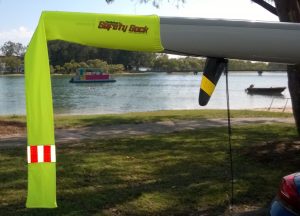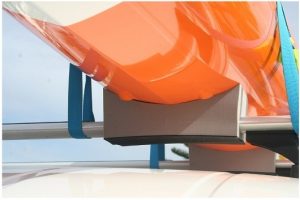Not all of us are fortunate enough to live right on our favourite waterway so we can just jump on/in our craft and paddle away. Most of us will (from time to time) need to transport our Ski or Kayak on a vehicle to reach our chosen launch location.
Did you know that (statistically) more craft are damaged in transit than in use? Mounting a ski on vehicle racks sounds easy, but get it wrong and you jeopardise the safety of your craft, your vehicle, yourself and other road users.
Here are a few tips you might find useful:
- Familiarise yourself with the “projecting load” road transport regulations in your state. Most skis are longer than your average vehicle, so there’s usually some overhang and it’s important to know what’s legal and what’s not. Depending your state, fines of up to $1,000 can be imposed for carrying a craft in the wrong manner. Excerpts from the Australian State regulations are listed at the bottom of this Blog.
- Always use a tail flag to mark the end of your craft. Even if you don’t think it projects far enough to warrant a flag, put one on! It allows other drivers (and pedestrians) to see it and if you’re reversing, it allows you to see the end of the craft too. The PaddleSmart “Safety Sock” is the best, most versatile and easily seen flag available and it’s the cheapest insurance you can buy. Get one!

PaddleSmart Safety Sock - Ensure your craft is “balanced” on your racks. The balance-point of your ski or kayak should be positioned mid-way between the racks, and the racks themselves far enough apart that the craft is well supported. 750mm should be the absolute minimum rack separation for carrying a ski. 1500mm is ideal. Fit rack extensions if necessary.
- Use watercraft cradles on your racks to support, protect and locate the craft. Many types of cradles are available, but the best we’ve found are specially shaped high-density foam cradles. These are gentler on the craft, support it better, locate it more positively and are much cheaper than the hard, adjustable variety. We use these “foamies” exclusively and strongly recommend them. (We sell them too, – because so many people wanted to know where to get them!)

- Use purpose-built, flat webbing tie-down straps for securing your craft on the racks/cradles. These will distribute the pressure much more evenly than rope or Octopus straps and they are far less likely to loosen off during transport. Always (always!) secure the loose end of the straps, such that they don’t flap around in the breeze and/or run the risk of being caught on a passing vehicle or obstacle. If they do, the result won’t be pretty!
So that’s about it, – racks, cradles, tie-downs and flag. One final thing though. When you’re driving with a ski on top, REMEMBER IT’S THERE! Low garage entries have damaged as many craft as the biggest waves, – probably more! 🙂
Paddle safe,
PaddleSmart
___________________________________________________________________________________________________________
Projecting Load Regulations by State (Government Website Excerpts)
New South Wales:
If the rear projection is greater than 1.2 metres, the rear of the load or equipment must have attached a brightly coloured flag not less than 300 mm. In addition to the flag, when travelling at night or in adverse weather conditions that restrict visibility, a red light or at least two red reflectors must be attached: The red light needs to be seen for 200 metres and the reflectors need to be capable of projecting a red reflection of light. These requirements also apply to any load or equipment that projects less than 1.2 metres, if it projects in such a way that it is not readily visible to a person following immediately behind the vehicle.
Victoria:
Where a load projects more than 1.2 metres beyond the rear of a vehicle, or a projecting load can not easily be seen by a driver following the vehicle, a brightly coloured flag of at least 30 centimetres must be attached to the rear of the load during the day and a red light or red reflectors attached during the night.
Queensland:
You must display a brightly coloured yellow, or red and yellow flag of least 450mm, fixed to the extreme back of the “projecting load”. You must display a red warning light that is visible from at least 200m away, OR at least 2 red reflectors capable of reflecting the headlights of a following vehicle. All warning devices must be displayed at the very end of your load; and be clearly visible to other people.
South Australia:
The rear of a load on a vehicle must carry a warning signal if the load projects more than 1.2 metres or cannot be easily seen. In the daytime, the warning signal must be a brightly coloured flag measuring at least 300mm. At night, the warning signal must be a red light or two red reflectors that can be seen for 200 metres, a bicycle tail-light may be used.
Western Australia:
Where any portion of the load or equipment on a vehicle projects in such a manner that it would not be readily visible to any person following immediately behind the vehicle, the driver of the vehicle must: (a) mark the end of the load or equipment, by means of a brightly coloured flag at least 300 mm long, so that it is clearly visible to persons in its vicinity; or (b) at night time, fit to the extreme end of the load or equipment a light showing a clear red light or reflector to the rear, visible at a distance of 200 m.
Tasmania:
Never carry a load that projects in a way that is dangerous to a person or property, even if the dimension limits and warning requirements meet and comply with the regulations.
If permitted and the overhang exceeds 1.2m rearward from the end of the vehicle, during operation in daylight hours (between sunrise & sunset), a red, yellow or combined red and yellow flag that is at least 30 cm must be affixed to the rear extremity of the load, and If the same vehicle is operated as above during hours of darkness (between sunset & sunrise), a red light or red reflectors visible for 200 metres should be affixed to and clearly displayed at the rear extremity of the load.
Fines:
Fines imposed for carrying improperly flagged and/or illuminated projecting loads vary between state jurisdictions and may also vary within a jurisdiction depending on the severity of the offence. These fines range from $252 to $1,100 across Australian states.
NOTE: All states require that the maximum rear projection of the load should not exceed an amount equivalent to 60% of the vehicle’s wheelbase as measured from the rear axle back, regardless of any flag fitted.
For more information, visit each state’s respective transport regulation website.